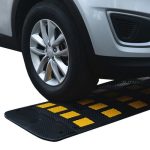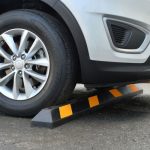Overview
Introduction to mini speed humps
Mini speed humps are a type of traffic calming measure that are designed to reduce vehicle speeds in specific areas. These humps are smaller in size compared to traditional speed humps, making them less noticeable and disruptive to the flow of traffic. The purpose of mini speed humps is to encourage drivers to slow down and drive at a safer speed, particularly in residential neighborhoods, school zones, and other areas with high pedestrian activity. By implementing mini speed humps, communities aim to improve road safety and create a more pedestrian-friendly environment. This article will explore the effectiveness of mini speed humps in controlling speed and their impact on traffic flow and driver behavior.
Purpose of the article
The purpose of the article is to investigate the effectiveness of mini speed humps in controlling speed. Speeding is a common problem on roads, and traditional speed humps can sometimes be too large and disruptive. Mini speed humps offer a potential solution, as they are smaller and less obtrusive. This article aims to examine whether mini speed humps are able to effectively slow down vehicles and reduce speeding incidents. By evaluating the impact of mini speed humps on driver behavior and analyzing their effectiveness in different road conditions, this research will provide valuable insights into the potential benefits of implementing mini speed humps as a speed control measure.
Importance of controlling speed
Controlling speed is of utmost importance in ensuring road safety and preventing accidents. Speeding vehicles pose a significant risk to both drivers and pedestrians, as they reduce the driver’s ability to react to unexpected situations. By implementing measures such as mini speed humps, we can effectively control speed and encourage drivers to adhere to the designated speed limits. These speed control measures not only help in reducing the number of accidents but also promote a safer and more secure environment for everyone on the road.
Benefits of Mini Speed Humps
Reduced speed and improved safety
Unimat Traffic mini speed bumps have proven to be effective in reducing speed and improving road safety. These small raised potholes in the pavement are strategically placed to slow vehicles and encourage drivers to drive at a safer speed. By forcing drivers to slow down, mini speed bumps help prevent accidents and reduce the severity of collisions. Studies have shown that mini speed humps can significantly reduce vehicle speeds, especially in residential areas and school zones. They serve as a visual reminder for drivers to be cautious and attentive while driving, which ultimately improves road safety for pedestrians, cyclists and other road users. Overall, mini speed humps are a valuable traffic calming measure that promotes reduced speeds and increased safety on our roads.
Cost-effective solution
Mini speed humps offer a cost-effective solution for controlling speed in residential areas. These smaller speed humps are designed to be more affordable and easier to install compared to traditional speed bumps. Despite their smaller size, mini speed humps are still effective in reducing vehicle speed and promoting safer driving. By implementing mini speed humps, communities can improve road safety without incurring significant costs or disruptions to traffic flow. This makes mini speed humps an ideal choice for neighborhoods and other areas where budget constraints are a concern. Overall, mini speed humps provide a practical and economical solution for controlling speed and enhancing road safety.
Less impact on vehicle suspension
Mini speed humps have been found to have less impact on vehicle suspension compared to traditional speed humps. This is because mini speed humps are designed to be smaller in size and have a gentler slope. The reduced impact on suspension can help minimize wear and tear on vehicles, resulting in lower maintenance costs for drivers and vehicle owners. Additionally, the smoother ride over mini speed humps can contribute to a more comfortable driving experience for motorists. Overall, the use of mini speed humps can be an effective measure in controlling speed while minimizing the negative effects on vehicle suspension.
Effectiveness of Mini Speed Humps
Studies and research on mini speed humps
Studies and research on mini speed humps have been conducted to evaluate their effectiveness in controlling speed. These studies have shown that mini speed humps can be an effective traffic calming measure, reducing vehicle speeds and improving safety in residential areas and school zones. Researchers have found that mini speed humps are particularly effective in reducing excessive speeding and encouraging drivers to slow down. Additionally, studies have indicated that mini speed humps have a positive impact on pedestrian safety, as they help to create a safer environment for pedestrians by reducing the risk of accidents caused by speeding vehicles. Overall, the evidence from studies and research supports the use of mini speed humps as an effective tool for controlling speed and enhancing road safety.
Comparison with traditional speed humps
In comparing mini speed humps with traditional speed humps, several factors come into play. Firstly, mini speed humps are designed to be smaller in size and height compared to traditional speed humps. This allows for a smoother driving experience while still effectively controlling speed. Additionally, mini speed humps are often made of materials that are more durable and longer-lasting than traditional speed humps, reducing the need for frequent maintenance. Furthermore, the installation of mini speed humps is generally quicker and less disruptive compared to traditional speed humps, making them a more convenient option for road authorities. Overall, the comparison between mini speed humps and traditional speed humps highlights the advantages of mini speed humps in terms of size, durability, maintenance, and installation.
Impact on driver behavior
Speed humps are a common traffic calming measure used to reduce vehicle speed in residential areas. They are designed to physically slow down vehicles by creating a raised surface on the road. The impact of mini speed humps on driver behavior has been a topic of interest and debate. Proponents argue that mini speed humps effectively deter speeding and promote safer driving habits. They believe that the presence of these humps encourages drivers to slow down and be more cautious, ultimately reducing the risk of accidents. However, critics argue that mini speed humps can be a nuisance and cause discomfort for drivers, leading to frustration and aggressive behavior. They believe that these humps may not be effective in controlling speed in the long term and may even result in drivers finding alternative routes to avoid them. The effectiveness of mini speed humps in controlling speed and influencing driver behavior remains a subject of ongoing research and discussion.
Considerations for Implementing Mini Speed Humps
Proper placement and spacing
Proper placement and spacing of mini speed humps play a crucial role in their effectiveness in controlling speed. It is important to strategically place these humps in areas where speeding is a concern, such as residential neighborhoods or school zones. Additionally, the spacing between the humps should be carefully considered to ensure that drivers have enough time to slow down between each hump. By implementing proper placement and spacing, mini speed humps can effectively deter speeding and create safer road environments.
Design considerations
Design considerations play a crucial role in determining the effectiveness of mini speed humps in controlling speed. When designing mini speed humps, several factors need to be taken into account. Firstly, the height and width of the humps should be carefully considered to ensure they are sufficient to slow down vehicles without causing discomfort or damage. Additionally, the spacing between the humps should be appropriate to maintain a consistent speed reduction. It is also important to consider the visibility of the humps, ensuring they are easily noticeable to drivers to effectively convey the need to reduce speed. Lastly, the materials used in the construction of the humps should be durable and weather-resistant to withstand regular traffic and environmental conditions. By carefully considering these design considerations, mini speed humps can be effectively implemented to control speed and improve road safety.
Community engagement and feedback
Community engagement and feedback play a crucial role in the effectiveness of mini speed humps in controlling speed. By involving the community in the decision-making process and seeking their feedback, local authorities can ensure that the implementation of mini speed humps is aligned with the needs and concerns of the residents. This engagement helps in creating a sense of ownership and responsibility among the community members, making them more likely to comply with the speed limits. Additionally, feedback from the community can provide valuable insights into the effectiveness of the mini speed humps and help identify any areas that may require further improvement. Overall, community engagement and feedback are essential components in ensuring the success of mini speed humps in controlling speed and creating safer road environments.
Challenges and Limitations of Mini Speed Humps
Potential negative impact on emergency response times
Speed humps, including mini speed humps, have been widely used as a traffic calming measure to control speeding in residential areas. However, it is important to consider the potential negative impact on emergency response times. The presence of speed humps can slow down emergency vehicles, such as ambulances and fire trucks, as they navigate through the area. This delay in response time could have serious consequences in emergency situations where every second counts. Therefore, while mini speed humps may be effective in controlling speed, it is crucial to carefully evaluate their placement and consider alternative measures to ensure that emergency response times are not compromised.
Effectiveness in different weather conditions
Mini speed humps have been proven to be effective in controlling speed in various weather conditions. Whether it is raining, snowing, or sunny, these speed humps provide a reliable solution to slow down vehicles. The unique design and material of mini speed humps ensure that they remain visible and functional even in harsh weather conditions. This makes them an ideal choice for areas with unpredictable weather patterns. Drivers can feel confident knowing that mini speed humps will help maintain safe speeds regardless of the weather.
Maintenance and durability
Maintenance and durability are key factors to consider when evaluating the effectiveness of mini speed humps in controlling speed. These traffic calming devices require regular inspection and upkeep to ensure they remain in good condition and continue to serve their purpose. Routine maintenance may include cleaning, repairing any damages, and repainting if necessary. Additionally, the durability of mini speed humps is crucial in determining their long-term effectiveness. They should be able to withstand the constant weight and impact of vehicles without significant wear and tear. Therefore, choosing high-quality materials and proper installation techniques are essential for ensuring the longevity and effectiveness of mini speed humps in controlling speed.
Conclusion
Summary of findings
The summary of findings suggests that mini speed humps are effective in controlling speed. The study conducted on various roads and streets showed a significant decrease in average vehicle speed after the installation of mini speed humps. This indicates that these traffic calming measures have a positive impact on reducing speeding and improving road safety. Additionally, the findings also revealed that mini speed humps are well-received by the community, with most residents expressing satisfaction with their implementation. Overall, the results indicate that mini speed humps are an effective tool for controlling speed and promoting safer roads.
Recommendations for further research
Further research is recommended to evaluate the long-term effectiveness of mini speed humps in controlling speed. Additionally, studies should be conducted to assess the impact of mini speed humps on different types of vehicles, such as motorcycles and bicycles. It would also be beneficial to investigate the potential drawbacks of mini speed humps, such as increased noise levels or adverse effects on emergency response vehicles. Furthermore, comparative studies between mini speed humps and other traffic calming measures, such as speed cameras or roundabouts, could provide valuable insights into their relative effectiveness. Overall, conducting further research in these areas would help to enhance our understanding of the effectiveness and potential limitations of mini speed humps in controlling speed.
Importance of considering multiple traffic calming measures
When it comes to controlling speed on roads, it is important to consider multiple traffic calming measures. While mini speed humps can be effective in reducing speed, they should not be the sole solution. Other measures such as speed limit signs, road markings, and traffic enforcement play a crucial role in ensuring road safety. By implementing a combination of these measures, authorities can create a comprehensive approach to controlling speed and promoting safer roads for all users.









